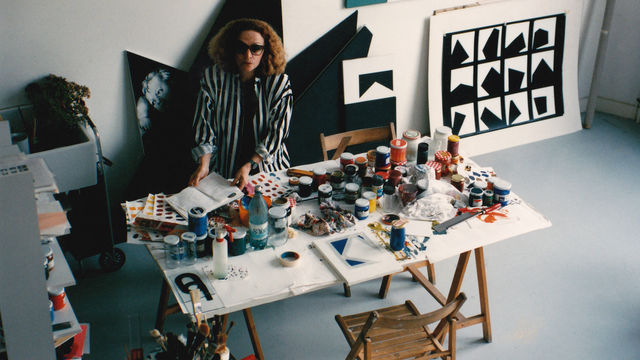
Lea Lublin
The Argentine artist Lea Lublin was born in Poland in 1929. Her family immigrated to Buenos Aires when she was nine years old. She graduated from the Escuela Nacional de Bellas Artes Prilidiano Pueyrredón in Buenos Aires in 1949. She first traveled to Paris in 1951 and attended the Académie Ranson and became close to the circle of figurative artists who created the Salon de la Jeune Peinture. She returned to Argentina in 1956 after receiving a grant from the Fondo Nacional de las Artes. In 1959 she lived for a brief time in the jungle region of Misiones, which borders Argentina, Brazil, and Paraguay. After this experience and following her return to Paris in 1964, she abandoned painting to become a conceptual and multimedia artist. In 1968 Lublin was invited to participate in the 24th Salon de Mai in Paris, for which she presented Mon fils (My son). During this exhibition-performance at the Musée d'Art Moderne de la Ville de Paris, Lublin cared for her seven-month-old son, Nicholas, playing with him, nursing him, and rocking him to sleep as well as changing his diapers.
While in Paris, Lublin maintained bonds with the art scene in Argentina. Also in 1968, and at the invitation of Jorge Romero Brest, director of the Instituto Torcuato Di Tella, Lublin created Terranautas (Earthnauts), a mazelike environment in a pitch-black space that the public could traverse barefoot. A work of a similar ecological bent yet of a more ambitious scale is the 1969 environment titled Fluvio subtunal (Subtunnel flow), an art project made to coincide with the inauguration of a tunnel built under the Paraná River to connect the provinces of Santa Fé and Entre Ríos. Lublin's Fluvio was structured as a walk through nine zones that ended with an inflatable plastic tunnel roughly sixty-six feet long.
In the early 1970s Lublin returned to Paris, where she began a new series questioning common assumptions about the discourse of art. Combining her interest in semiotics, psychology, and sociology, the dialogue-based project consisted of impromptu interviews with passersby aided by a banner with stenciled questions used to trigger conversation. From the end of the 1980s into the early 1990s Lublin carried out a research project investigating the sojourn of Marcel Duchamp (1887–1968) in Buenos Aires in 1918–19. Lublin died in Paris in 1999. Her works are collected by major art museums, including the Museum of Modern Art in New York and the Centre Pompidou in Paris, and many works are still in the estate of the artist and in the collection of Nicholas Lublin. In 2015 the Lenbachhaus in Munich organized the first retrospective of Lublin's career.
—Marcela Guerrero
Selected Solo Exhibitions
1958 Galería Van Riel, Buenos Aires
1963 Bestias y explosiones de Lea Lublin, Galería Riobóo, Buenos Aires
1971 Cultura: Dentro y fuera del museo, Museo Nacional de Bellas Artes, Santiago
1983 The Striptease of the Child-God, Galerie Yvon Lambert, Paris
1995 Léa Lublin: Mémoire des lieux—mémoires du corps, Centre d'Art Contemporain de Quimper, France
Selected Bibliography
Bernadac, Marie-Laure, and Bernard Marcadé. Fémininmasculin: Le sexe de l'art. Paris: Gallimard/Electa and Centre Pompidou, 1995.
Lea Lublin: Proceso a la imagen; Recorrido conceptual; Elementos para una reflexión activa. Buenos Aires: Galería Carmen Waugh, 1970.
Looy, Glenn van, and Gerda van Obbergen. Lea Lublin: Parcours, 1965–1975. Antwerp: Internationaal Cultureel Centrum, 1975.
Plante, Isabel. "Between Paris and the 'Third World': Lea Lublin's Long 1960s." Artl@s Bulletin 3, no. 2 (2015): Article 4.
Weber, Stephanie, et al. Lea Lublin: Retrospective. Munich: Lenbachhaus; Cologne: Snoeck, 2015.


